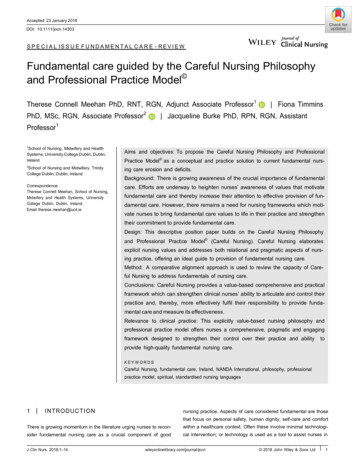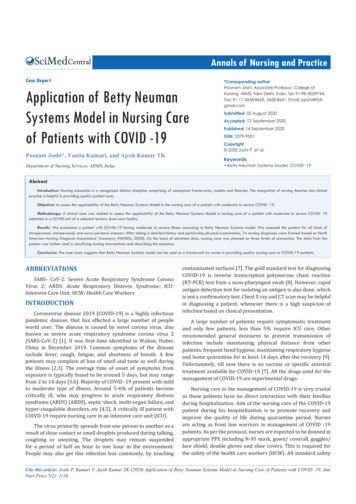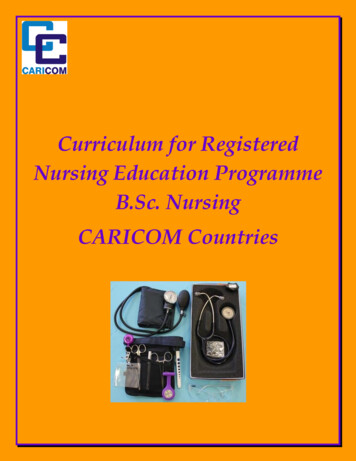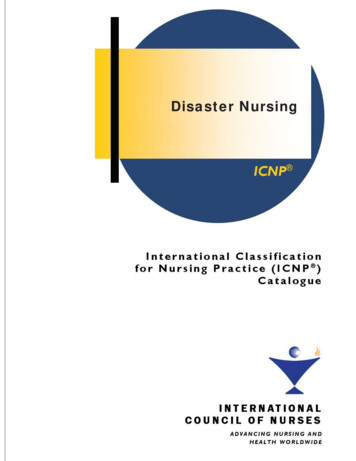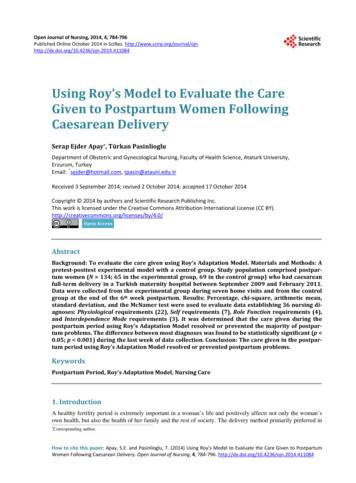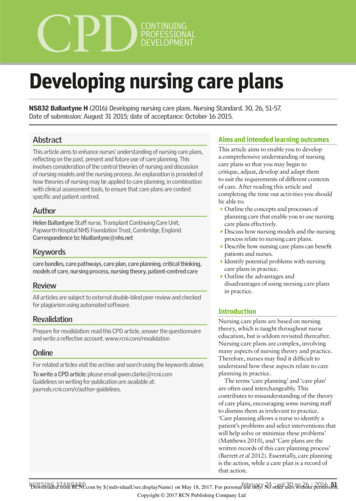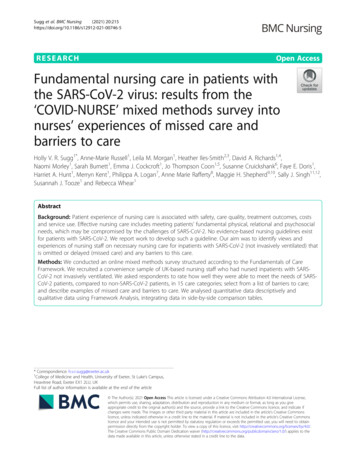
Transcription
Sugg et al. BMC Nursing(2021) SEARCHOpen AccessFundamental nursing care in patients withthe SARS-CoV-2 virus: results from the‘COVID-NURSE’ mixed methods survey intonurses’ experiences of missed care andbarriers to careHolly V. R. Sugg1*, Anne-Marie Russell1, Leila M. Morgan1, Heather Iles-Smith2,3, David A. Richards1,4,Naomi Morley1, Sarah Burnett1, Emma J. Cockcroft1, Jo Thompson Coon1,5, Susanne Cruickshank6, Faye E. Doris1,Harriet A. Hunt1, Merryn Kent1, Philippa A. Logan7, Anne Marie Rafferty8, Maggie H. Shepherd9,10, Sally J. Singh11,12,Susannah J. Tooze1 and Rebecca Whear1AbstractBackground: Patient experience of nursing care is associated with safety, care quality, treatment outcomes, costsand service use. Effective nursing care includes meeting patients’ fundamental physical, relational and psychosocialneeds, which may be compromised by the challenges of SARS-CoV-2. No evidence-based nursing guidelines existfor patients with SARS-CoV-2. We report work to develop such a guideline. Our aim was to identify views andexperiences of nursing staff on necessary nursing care for inpatients with SARS-CoV-2 (not invasively ventilated) thatis omitted or delayed (missed care) and any barriers to this care.Methods: We conducted an online mixed methods survey structured according to the Fundamentals of CareFramework. We recruited a convenience sample of UK-based nursing staff who had nursed inpatients with SARSCoV-2 not invasively ventilated. We asked respondents to rate how well they were able to meet the needs of SARSCoV-2 patients, compared to non-SARS-CoV-2 patients, in 15 care categories; select from a list of barriers to care;and describe examples of missed care and barriers to care. We analysed quantitative data descriptively andqualitative data using Framework Analysis, integrating data in side-by-side comparison tables.* Correspondence: h.v.r.sugg@exeter.ac.uk1College of Medicine and Health, University of Exeter, St Luke’s Campus,Heavitree Road, Exeter EX1 2LU, UKFull list of author information is available at the end of the article The Author(s). 2021 Open Access This article is licensed under a Creative Commons Attribution 4.0 International License,which permits use, sharing, adaptation, distribution and reproduction in any medium or format, as long as you giveappropriate credit to the original author(s) and the source, provide a link to the Creative Commons licence, and indicate ifchanges were made. The images or other third party material in this article are included in the article's Creative Commonslicence, unless indicated otherwise in a credit line to the material. If material is not included in the article's Creative Commonslicence and your intended use is not permitted by statutory regulation or exceeds the permitted use, you will need to obtainpermission directly from the copyright holder. To view a copy of this licence, visit http://creativecommons.org/licenses/by/4.0/.The Creative Commons Public Domain Dedication waiver ) applies to thedata made available in this article, unless otherwise stated in a credit line to the data.
Sugg et al. BMC Nursing(2021) 20:215Page 2 of 17Results: Of 1062 respondents, the majority rated mobility, talking and listening, non-verbal communication,communicating with significant others, and emotional wellbeing as worse for patients with SARS-CoV-2. Eightbarriers were ranked within the top five in at least one of the three care areas. These were (in rank order): wearingPersonal Protective Equipment, the severity of patients’ conditions, inability to take items in and out of isolationrooms without donning and doffing Personal Protective Equipment, lack of time to spend with patients, lack ofpresence from specialised services e.g. physiotherapists, lack of knowledge about SARS-CoV-2, insufficient stock, andreluctance to spend time with patients for fear of catching SARS-CoV-2.Conclusions: Our respondents identified nursing care areas likely to be missed for patients with SARS-CoV-2, andbarriers to delivering care. We are currently evaluating a guideline of nursing strategies to address these barriers,which are unlikely to be exclusive to this pandemic or the environments represented by our respondents. Ourresults should, therefore, be incorporated into global pandemic planning.Keywords: Fundamental nursing care, COVID-19, SARS-CoV-2, Missed care, Survey, Mixed methodsBackgroundPatient experience of care is associated with safety, clinical effectiveness, care quality, treatment outcomes, costsand service use [1–5], and nursing care is a key determinant of this experience [6, 7]. Although nurses perform both generalist and specialist roles, all nurses areinvolved in meeting patients’ ‘fundamental’ care needs.Defining fundamental care has in the past been a contested area [8], but there is now greater consensus [9] inthat fundamental care can be described as ‘actions onthe part of the nurse that respect and focus on a person’s essential needs to ensure their physical and psychosocial wellbeing’ ( [9], p.2292). These needs are metby developing a positive and trusting relationship withthe person being cared for as well as their family/carers[10]. Therefore, the discrete elements of fundamentalcare can be described as: actions to meet patients’ physical needs, and their psychosocial (wellbeing and mentalhealth) needs; these actions include nurses’ transactionaland relational behaviours [9].The combination of SARS-CoV-2 symptoms and infectiousness of the SARS-CoV-2 virus may pose significant challenges for meeting patients’ physical andpsychosocial needs, as well as impacting on nurses’ relational and transactional care behaviours. Such challengesmay result in ‘missed care’ or ‘care left undone’, definedas any aspect of nursing care that is omitted or delayed,in part or in whole [11, 12]. Whilst our current study focuses specifically on fundamental nursing care, missedcare can therefore include areas of fundamental nursingcare (e.g. meeting patients’ hygiene needs) as well asother areas of nursing care (e.g. discharge planning) [13].Prior to the SARS-CoV-2 pandemic, both nurses and patients indicated that important elements of fundamentalnursing care are regularly missed, including nutrition,hygiene (e.g. bathing; mouth care), ambulation/ supportingmobility, communication/ talking with patients, andemotional and psychological support [13–17]. The extentof missed care is related to poor patient outcomes,increased mortality and adverse events, and poor patientsatisfaction and experience of care [15, 18–20]. Factors contributing to missed care include high patient to registerednurse ratios, associated lack of nurse time, patient dependency/ acuity, and the practice environment (e.g. managerialsupport) [12, 16, 17, 21], and the likely impact of the SARSCoV-2 pandemic on all of these factors may further increase incidences of missed care. Indeed, we know fromnurses’ narrative accounts of the Canadian SARS outbreakin 2003 that Personal Protective Equipment (PPE) [22],time pressures [23] and visitor restrictions [24] can lead topatients feeling abandoned by nurses [23].Given the short time since the SARS-CoV-2 virus firstemerged in late 2019, knowledge of its impact on nursing care has been slow to emerge and as yet there is nodirect data on patients’ experience of nursing care. Mostof the research published to date has focussed on theimpact on nurses’ wellbeing, not on their processes ofcaring. Thus, we know from surveys conducted in Chinaand Italy that front-line nurses have experienced hugeworkload; long-term fatigue; infection threat; and anxieties and frustration concerning the death of patients forwhom they cared. Additionally, they worried about theirfamilies and vice versa [25]. A survey completed by 764nurses (60.8%) and 493 physicians (39.2%) from 34 hospitals in China reported symptoms of depression (634[50.4%]), anxiety (560 [44.6%]), insomnia (427 [34.0%]),and distress (899 [71.5%]) amongst the health careworkers. Nurses, frontline health care workers, femalehealth care workers, and those working in Wuhan, reported more severe mental health symptoms than otherhealth care workers [26]. Nurses in Italy reported PostTraumatic Stress Disorder symptoms, severe depression,anxiety, insomnia and perceived stress [27], and UKnurses were concerned about the risks of SARS-CoV-2on their physical and mental health, as well as the healthof their families [28, 29].
Sugg et al. BMC Nursing(2021) 20:215There is evidence emerging from the UK that theseeffects on nurses, together with the rapid adjustment ofhealthcare systems to accommodate the pressures of increased patient flow, redeployment of inexperienced staffinto isolation care environments, and other factors, mayhave had a negative impact on patients. One survey onrecovered patients’ experiences at discharge found that82% of respondents had not received post-discharge assessment visits, and 18% reported having unmet needs[30]. Thus, the negative impact of the SARS-CoV-2 outbreak on nurses may in turn impact patients, acting as amediator of missed care. However, we do not currentlyknow if the concerns raised in the brief reports from theCanadian SARS outbreak have been replicated or learntfrom in this current pandemic, and there are currentlyno evidence-based guidelines for nursing patients withSARS-CoV-2 who may be receiving ventilatory supportwithout tracheal intubation (i.e. not invasively ventilated), who represent the majority of hospitalised patients with this condition. This leaves nurses withoutguidance and is potentially associated with variations inpatient experience, care quality and costs as redeployedand/or inexperienced nurses struggle to adapt tocaring for patients in strict isolation [31] using unfamiliarcare procedures required for infection prevention andcontrol [32].We designed the COVID-NURSE cluster randomisedcontrolled trial [33] to evaluate a fundamental nursingcare protocol for patients hospitalised with the SARSCoV-2 virus not invasively ventilated. The fundamentalnursing care protocol has been developed from threemain areas of activity: i) a survey of registered nurses’and non-registered auxiliary nursing/ healthcare supportworkers and assistants’ views and experiences of caringfor patients with SARS-CoV-2 including the barriers encountered in delivering fundamental care and strategiesadopted to overcome these; ii) a rapid systematic reviewof the literature [34]; and iii) four co-creation workshopsinvolving nurses and patients with experience of beinghospitalised with the SARS-CoV-2 virus not invasivelyventilated, in which the findings from the survey and thesystematic review were presented and discussed.In this paper, we report the findings from the surveyof nurses that relate to their views and experiences ofmissed fundamental care and barriers to fundamentalcare for inpatients with SARS-CoV-2 not invasively ventilated. We will report findings on strategies used toovercome the barriers to care in a future article, to avoidpotential contamination of the trial before completion.MethodsAim and designOur aim was to identify the views and experiences ofregistered nurses and non-registered nursing care staffPage 3 of 17on missed fundamental care and the barriers to fundamental care for inpatients with the SARS-CoV-2 virusnot invasively ventilated. We conducted a cross-sectionalstudy employing a mixed methods explanatory design[35] guided by a pragmatic philosophy [36]. For thequantitative and qualitative components, we collecteddata concurrently and analysed data sequentially (withqualitative data analysed in order to explain the quantitative data). We gave the quantitative component greaterpriority as this guided our analysis of qualitative data,and we mixed the components during data analysis. Thisapproach enabled us to utilise the qualitative data toelaborate on, clarify, illustrate and contextualise the keyquantitative findings [37, 38].Participants and recruitmentEligible respondents were UK-based registered nursesand non-registered auxiliary nursing/ healthcare supportworkers/ assistants that had actively engaged in nursinginpatients with the SARS-CoV-2 virus who were not invasively ventilated. Thus, respondents who had nursedpatients who were not ventilated, or patients who received non-invasive ventilation, were eligible; respondents who only nursed invasively ventilated patientswere ineligible. We invited a convenience sample ofrespondents using a range of strategies; including a database of nurses who had consented to be approached forSARS-CoV-2 related research studies through their involvement in the ‘Impact of COVID-19 on the Nursingand midwifery workforce’ (ICON) study [29]; networksof senior research, management and clinical nurses inEngland and Wales including contacts within theNational Institute for Health Research (NIHR) 70@70research network, the Association of UK Lead ResearchNurses, the Royal Colleges, and hospital sites affiliatedwith the COVID-NURSE Trial co-investigators; the UKNIHR Clinical Research Network; and through socialmedia including Twitter and University of Exeter channels. We aimed for our survey distribution channels tobe as inclusive as possible in terms of encouragingresponses from nurses working in different types ofhospitals, including general vs. specialist, which weregeographically diverse and serving populations of different ethnicities.We sent a link to the survey to nurses on our databaseand to key gatekeepers in the networks listed above. Weasked gatekeepers to circulate the link via newsletters,emails and other communication channels appropriateto their networks with a covering letter informing potential respondents of the purpose and timeframe for thesurvey. The landing page for the survey provided linksto the participant information sheet, frequently askedquestions, and the survey. As this was an exploratorystudy to guide our intervention development, within the
Sugg et al. BMC Nursing(2021) 20:215specific time limits of the COVID-NURSE trial and thususing a convenience sampling frame, we did not have apredetermined sample size calculation and sought torecruit as many respondents as possible during the timeframe of the survey.Data collection and materialsThe survey was open for 3 weeks, plus 3 days to respondents who had commenced the survey, to provide the opportunity to complete it. We developed the survey withinput from the COVID-NURSE trial Co-Investigators andmembers of the wider research team, in response to formal and informal feedback from four nursing teams whopiloted the survey, and in line with comments from theUniversity of Exeter Medical School Ethics Committee. Atall times in the development of the survey we involvedmembers of our patient and public involvement group(PPI) including our PPI co-investigators and trial management group member, who gave us advice on the surveydesign. Using Qualtrics online survey software [39], wedesigned a bespoke online series of survey questionsincluding demographic items. We structured our surveyaccording to the Fundamentals of Care model [8, 9]. Weincluded three sections on physical, relational and psychosocial areas of care, and subsections in each of these areascorresponding to sub-categories of care as adapted fromFeo et al. (2018) [9] (Table 1).In each subsection (Table 1), we asked respondents to: Rate how well they thought they were able to meetPage 4 of 17(excluding those who had been invasively ventilated)compared to their ability to meet the needs of otherpatients they were experienced in nursing beforeSARS-CoV-2. For example, for section one (physicalcare), subsection one, respondents were asked torate how well they were able to meet the hygiene,personal cleansing and toileting needs of patientswith the SARS-CoV-2 virus (excluding those whohad been invasively ventilated) compared to theirability to meet the hygiene, personal cleansing andtoileting needs of other patients they wereexperienced in nursing before SARS-CoV-2.Respondents were asked to provide answers on a fivepoint Likert-type scale with the following options:much better than, a little bit better than, the sameas, a bit worse than, or much worse than.Alternatively, respondents could indicate that theywere not involved in this area of care; Provide free text to narratively identify and describeexamples of missed fundamental care; Select all relevant barriers to fundamental care froma list provided. The barrier list was derived fromdiscussions with the COVID-NURSE trial CoInvestigators with expertise in nursing. Barriers werestandardised across all sub-categories, withadditional barriers added where relevant for aspecific category. A list of barriers available for eachsub-category is provided in Additional file 1; Provide free text to narratively identify and describeexamples of barriers to fundamental care.the needs of patients with the SARS-CoV-2 virusData analysisTable 1 Survey structure; fundamental care areas and subcategories of careSection: Care areaSubsection: Sub-category of care1. Physical1. Hygiene, personal cleansing and toileting2. Eating and drinking3. Rest and sleep4. Mobility5. Patient comfort6. Patient safety7. Medication management2. Relational1. Establishing a relationship with patients2. Talking and listening3. Non-verbal communication4. Shared decision-making5. Communicating with relatives, carers andsignificant others3. Psychosocial1. Dignity and respect2. Respecting patients’ values and beliefs3. Wellbeing, anxiety and depressionThe UK Clinical Research Collaboration (UKCRC)-registered University of Exeter Clinical Trials Unit received,cleaned and processed the data, and uploaded datasetsto Microsoft Excel [40]. We applied pairwise deletion toeach survey item in order to maximise the data available,and reported all percentages as the percentage of thetotal number of respondents who provided data for thatsurvey item. We combined ethnicity data into standardcategories [41].Quantitative data analysisWe analysed quantitative data, including demographicdata, descriptively. For respondents’ ratings of care, wecombined responses into four categories for ease of interpretation: 1) better than other patients (combining‘much better’ and ‘a little bit better’); 2) the same asother patients; 3) worse than other patients (combining‘much worse’ and ‘a bit worse’); 4) not involved in thisarea of care. For both ratings of care and barriers tocare, we calculated the frequency, and percentage, of respondents selecting each option for each sub-category ofcare. We also calculated the percentage of respondents
Sugg et al. BMC Nursing(2021) 20:215selecting each barrier in total across each of the threecare areas (physical; relational; psychosocial).Qualitative and mixed methods data analysisWe achieved familiarisation with the data through readingsurvey responses and analysed data using FrameworkAnalysis [42] to allow for both inductive and deductive approaches in combining our study aims/ survey questionswith participants’ original accounts [42, 43]. In undertaking qualitative analysis within our explanatory mixedmethods design, we focused on explaining the key quantitative findings rather than completing a full, independentanalysis of qualitative themes, so that we could understandrespondents’ meanings in providing their quantitativeresponses and focus in on qualitative examples in keyproblem areas indicated by the quantitative data.Data interpretation and the development of analyticcategories were discussed by a multidisciplinary teamtrained in qualitative data analysis and consisting of fiveresearchers (HVRS, A-MR, HI-S, DAR, NM) with backgrounds in nursing (3), nursing education (3), mentalhealth services research (2) and clinical research (2). Theteam was led by HVRS; A-MR, HI-S, NM and HVRS independently coded subsets of the raw data; HVRSdouble-coded and verified subsets of the data coded byA-MR, HI-S and NM.For missed care and barriers, we separately codedresponses into a framework structured according to theFundamentals of Care Framework. Within each subcategory of care, we analysed survey responses thematicallyusing a constant comparison approach, and examined similarities and differences in respondents’ accounts in order tocategorise the examples of missed care and barriers for eachsub-category [44, 45]. For barriers to care, we then focusedour analysis on the main barriers highlighted by the quantitative data, categorising the qualitative findings across allsub-categories of care into each of the top five rated barriers for each of the three care areas (physical; relational;psychosocial). We have integrated the quantitative andqualitative data in side-by-side comparison tables [35] organised by the quantitative data (for missed care, from highestto lowest percentage of respondents rating the sub-categoryof care as ‘worse’; for barriers to care, from highest to lowest percentage of respondents selecting the barrier). Inthese tables we have included summaries of the qualitativefindings and quotes to illuminate these.We describe our study in line with cross-sectionalstudy reporting guidelines (see Additional file 2 for completed STROBE checklist) [46].ResultsRespondent characteristicsFrom 3rd to 26th August 2020, 1062 eligible respondents consented to provide survey data; 84 of thesePage 5 of 17provided no further data. The number of respondentsproviding data for each survey item is provided inAdditional file 1. Respondent characteristics are summarised in Table 2.Respondents’ views on missed fundamental careQuantitative resultsThe percentage of respondents rating the physical,relational and psychosocial care of patients with theSARS-CoV-2 as worse, the same as, or better than otherpatients, for each constituent sub-category of care, isshown in Figs. 1, 2 and 3. Frequencies are provided inAdditional file 1.For sub-categories of care across all three care areas(physical, relational, psychosocial), a majority ofrespondents rated their ability to meet the needs ofSARS-CoV-2 patients as worse than for other patients.The following sub-categories were rated as worse by amajority of respondents: ‘talking and listening’ (57%);‘communicating with relatives, carers and significantothers’ (57%); ‘mobility’ (56%); ‘non-verbal communication’ (54%); ‘emotional wellbeing, anxiety and depression’(53%). Just less than half (49%) of respondents also rated‘establishing a relationship with patients’ as worse forSARS-CoV-2 patients. For all the other physical subcategories (aside from ‘mobility’), approximately onethird or less of respondents rated care as worse forSARS-CoV-2 patients (range 26–34%). For relationalcare, almost one third of respondents (32%) rated‘shared decision-making’ as worse for SARS-CoV-2 patients, and for psychosocial care ‘dignity and respect’ and‘respecting patients’ values and beliefs’ were rated asworse for SARS-CoV-2 patients by 26 and 19% of respondents respectively.Integrated quantitative and qualitative resultsIn Tables 3, 4 and 5 we have presented side-by-sidecomparison tables integrating the quantitative findingsand summarised qualitative findings on missed care foreach sub-category of physical, relational and psychosocial care. Respondents’ ID numbers are included inbrackets after quotes.Between 26 and 56% of respondents struggled tomeet all sub-categories of patients’ physical needs efficiently and effectively compared to patients they wouldnormally care for. Particularly highlighted were restrictions on patients’ mobilisation outside of side (isolation)rooms, and some respondents also described issues withinterrupted sleep; missed and delayed personal care, particularly mouth care; restrictions and delays in providingfood and drink; reductions in observing patients in siderooms; errors and potential for errors, particularlyaround medications; challenges with controlling symptoms of breathlessness and high temperature; missed
Sugg et al. BMC Nursing(2021) 20:215Page 6 of 17Table 2 Respondent characteristicsTable 2 Respondent characteristics (Continued)N (%)GenderAgeEthnicityEnvironmentCountryMain positionRedeployed?Female858 (87.7)Male112 (11.5)Prefer not to say8 (0.8) 2598 (10.0)26–30173 (17.7)31–40257 (26.3)41–50234 (23.9)51–60182 (18.6)61–6626 (2.7) 671 (0.1)Prefer not to say7 (0.7)Asian/ Asian British32 (3.3)Black/ African/ Caribbean/Black British15 (1.5)Mixed/ Multiple ethnic groups13 (1.3)Other ethnic group46 (4.7)Other White85 (8.7)White British779 (79.7)Prefer not to say8 (0.8)Acute General NHS hospitalincluding teaching hospital898 (91.8)Tertiary/ specialist63 (6.4)Private healthcare6 (0.6)Missing data11 (1.1)England933 (95.4)Wales15 (1.5)Scotland5 (0.5)Northern Ireland4 (0.4)Other country1 (0.1)Missing data20 (2.0)Charge nurse206 (21.1)Staff nurse374 (38.2)Specialist/ advanced nurse142 (14.5)Research nurse42 (4.3)Nurse researcher1 (0.1)Manager73 (7.5)Student nurse20 (2.0)Non-registered nursingassociate10 (1.0)Non-registered careor nursing assistant90 (9.2)Missing data20 (2.0)Yes139 (14.2)No227 (23.2)Missing data612 (62.6)N (%)Usually work onrespiratory warda?Usually work innon-warda environment?Yes114 (11.7)No252 (25.8)Missing data612 (62.6)Yes138 (14.1)No228 (23.3)Missing data612 (62.6)aWard: an inpatient division in a hospital typically shared by patients whoneed a similar type of care. Non-ward: a non-residential health care settingsuch as outpatient, community or primary care. Percentages may not alwaystotal 100 due to roundingpressure area care; and a lack of presence from multidisciplinary colleagues such as physiotherapists, dieticiansand pharmacists.In relational care, the majority of respondents (57%)highlighted communication difficulties with patients andtheir significant others, with almost half of respondentsreporting that this impacted on their ability to establisha relationship with patients. Respondents struggled tobuild rapport with patients; experienced restrictions inbeing heard, understood, and spending time with patients; and were less able to use facial expressions, nonverbal cues and touch to comfort patients. Respondentsreported that patients missed having visits from significant others, and they struggled to both keep significantothers informed and obtain information about patientsfrom them. A third of respondents also experiencedshared decision-making as more rushed and policy-ledthan usual.In psychosocial care, the majority of respondents(53%) reported struggling to support patients’ emotionalwellbeing and mental health, typically prioritisingfunctional and physical care over emotional care. Mostrespondents were unable to provide usual levels ofsupport, reassurance and interaction with patients, andreported that patients experienced isolation, loneliness,fear and low mood. A minority of respondents also haddifficulties maintaining patients’ privacy and dignity,such as drawing curtains for personal care or distressingscenes; lacked knowledge about patients’ beliefs; andnoted a lack of presence from psychological services andchaplaincy.Respondents’ views on barriers to fundamental careQuantitative resultsWe summarise the percentage of respondents selectingeach barrier in Table 6 (presented as the average percentage of respondents selecting the barrier, and therange of respondent percentages, across the constituentsub-categories of physical, relational and psychosocialcare; where the barrier was only an option for one subcategory, we just present the percentage of respondents
Sugg et al. BMC Nursing(2021) 20:215Page 7 of 17Fig. 1 Respondents’ ratings of meeting the physical care needs of patients with SARS-CoV-2selecting the barrier for that sub-category). We havelisted barriers in the order of most to least frequently selected across all care areas. We have provided the number of respondents selecting each barrier for each subcategory of care in Additional file 1.In total, eight barriers were ranked within the top fivein at least one of the three care areas (Tables 7, 8 and 9).‘Wearing PPE’, and the ‘severity of the patient’s condition’ were the most frequently selected barriers and wereamong the top five barriers to all three care areas. Thethird most frequently selected barrier, ‘difficulties takingitems/ equipment in and out of isolation rooms’, wasamong the top five barriers to physical care. ‘Lack oftime’, the fourth most frequently selected barrier, wasamong the top five barriers to both psychosocial and relational care. ‘Lack of personnel, skill mix, catering,housekeeping or dietetic support’, the fifth most frequently selected barrier, was among the top five barriersto both physical and psychosocial care. The sixth mostfrequently selected barrier, ‘lack of knowledge aboutCOVID-19’, was among the top five barriers to both relational and psychosocial care. The seventh most frequently selected barrier, ‘not enough physical resourcessuch as equipment/ washing facilities/ stock items’, wasthe final top five barrier to physical care. The eighthmost frequently selected barrier, ‘fear of catchingCOVID-19’, was the final top five barrier to relationalcare.Integrated quantitative and qualitative resultsIn Tables 7, 8 and 9 we report the top five barriers percare area in order of highest to lowest percentage of respondents selecting this barrier across the constituentsub-categories. We also include the sub-category forwhich the highest percentage of respondents selectedthe barrier in that care area, and then integrate thequalitative data in side-by-side comparison tables. Respondents’ ID numbers are included in brackets afterquotes.Respondents struggled to meet the physical care needs(particularly rest and sleep, mobility, eating/drinking,and personal care) of patients who were very unwell,often attached to oxygen equipment, and with highmonitoring requirements
as any aspect of nursing care that is omitted or delayed, in part or in whole [11, 12]. Whilst our current study fo-cuses specifically on fundamental nursing care, missed care can therefore include areas of fundamental nursing care (e.g. meeting patients' hygiene needs) as well as other areas of nursing care (e.g. discharge planning) [13].

